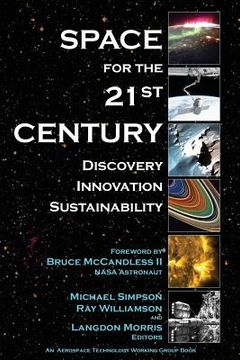Share
Space for the 21st Century: Discovery, Innovation, Sustainability (in English)
Williamson Ph. D., Ray ; Morris, Langdon ; Mccandless Ii, Bruce (Author)
·
Createspace Independent Publishing Platform
· Paperback
Space for the 21st Century: Discovery, Innovation, Sustainability (in English) - Williamson Ph. D., Ray ; Morris, Langdon ; McCandless II, Bruce
$ 19.96
$ 24.95
You save: $ 4.99
Choose the list to add your product or create one New List
✓ Product added successfully to the Wishlist.
Go to My WishlistsIt will be shipped from our warehouse between
Monday, June 24 and
Tuesday, June 25.
You will receive it anywhere in United States between 1 and 3 business days after shipment.
Synopsis "Space for the 21st Century: Discovery, Innovation, Sustainability (in English)"
FOREWORD By Bruce McCandless II Former NASA Astronaut This volume is the fifth in the series on contemporary space topics by the Aerospace Technology Working Group with support from Secure World Foundation, the International Space University, and the International Institute of Space Commerce. It deals principally with the topic of sustainability of space operations. In all fields of challenging endeavor actually accomplishing an objective (e.g., putting a satellite into orbit) comes first, followed by exploitation or commercialization, and lastly by a realization that the resource is finite. Such "finite-ness" may come from considerations of pollution (e.g., space debris, propulsion effluent) or of actual limitations on the availability of the resource (e.g., crowding of Geostationary Earth Orbit - GEO). Both of these topics are among those discussed in detail in this volume. Developing countries, in particular, may find such considerations too burdensome, and this begs the need for regulation to avoid the classic "Tragedy of the Commons" situation. In the case of orbital debris we have collectively arrived at a point where tens of millions of tiny pieces of debris are currently in orbit, decaying at diverse rates in a situation where a single flake of paint has been demonstrated to be capable of causing damage when impacting at high relative velocities. At the other end of the spectrum, defunct satellites (e.g., ESA's Envisat) present discrete problems worthy of individual retrieval/disposal efforts but fraught with complications arising from ownership to potentially still effective ITAR constraints on access to onboard technology. And, of course, the managers of the International Space Station are absolutely paranoid about higher altitude orbital debris eventually decaying to and ultimately impacting their very large orbiting facility. While space may realistically be dubbed "infinite," very specific orbits, or sets of orbits, have practical capacity limits. In GEO, for example, spacing of satellites along it are subject to constraints arising from use of the same radio frequency spectra and the size of ground based antennas required to spatially discriminate between adjacent satellites. In popular high inclination sun-synchronous Earth imaging orbits, these all converge near the poles, creating a traffic management concern arising from the risk of collision. The subject of "green propellants" is treated from several aspects. The Liquid Oxygen / Liquid Hydrogen system, while yielding only water vapor from combustion, may have a significant carbon footprint associated with the manufacture of the LH2 from methane or methanol. Aluminum oxide, an exhaust product of common solid propellant boosters is generally regarded as inert, but the inhalation of fine particles of it can cause pulmonary fibrosis or other lung damage in humans. Additionally the need for oxidizer depletion shutdown in the family of hydrazine/oxidizer booster stages results in significant quantities of UDMH (for example) being dispersed upon impact of the early stages. No Foreword can do adequate justice to the carefully developed material within the publication itself. For a detailed and thought provoking coverage of the principal topics associated with the sustainability of space operations, this book is highly recommended, authoritative, and "a good read."

